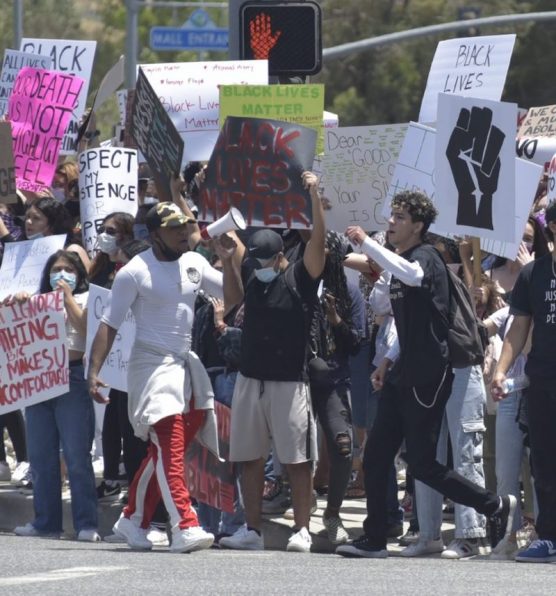Health experts say they’re worried that close contact at civil rights protests around the country spurred by the death of George Floyd could lead to a surge in COVID-19 cases.
Over the weekend, people gathered in every major city in America to protest police brutality against African Americans.
The death of Floyd – a black man who died after a white former Minneapolis police officer knelt on his neck for nearly nine minutes as Floyd shouted that he couldn’t breathe – sparked the nationwide unrest last week that continued through the weekend.
Many protesters wore masks and initially tried to keep their distance from each other because of the Covid-19 pandemic, but as the demonstrations grew – and in some places turned into riots and lootings – participants began to neglect the recommended 6-foot distance rule.
Law enforcement officers, too, have stood close to each other, often side-by-side in lines, as they monitored and in some cases engaged with protesters verbally and physically. Some officers used batons and pepper spray and fired tear gas and flash grenades at protesters.
Amanda Simanek, an associate professor of epidemiology at the University of Wisconsin-Milwaukee, rehashed in a phone interview Monday how the virus spreads.
“The primary transmission of coronavirus is through droplets — so when somebody sneezes or coughs, or even talks or sings, droplets get expelled and go into the air,” she said. “Many of them fall into the ground but if you’re nearby enough, you could encounter them in the air.”
She also said the coronavirus can be contracted indirectly by touching your face with contaminated hands. While public health experts are concerned about the increase in cases, they also recognize the importance of protesting structural racism, which Simanek said “is leading and contributing to the black population being disproportionately affected by COVID-19 and police brutality.”
Scientists from several institutions including Johns Hopkins University released a study last month showing that while black people make up 13.4% of the American population, counties with higher black populations made up more than half of all COVID-19 cases and almost 60% of deaths. This is likely because of social conditions, structural racism and other factors, the researchers said.
Police officers’ protective helmets and plastic shields may offer increased protection from contaminated droplets, protecting both the protesters and the police.
“There’s been a lot of emphasis on just what protesters should be doing to reduce their risk…and to kind of maintain distance where possible. But I think there has to be a shared approach in this pandemic scenario with police and others that are out there,” Simanek said, adding that police crowding protesters into each other and spraying tear gas that causes people to cough is not ideal for reducing the transmission of infection.
It could also be good practice to be tolerant of protesting practices that don’t involve shouting or yelling, like playing music or drums, she added.
Simanek said that while spreading Covid-19 is a concern during the protests, it is not unique to those situations.
“It’s a concern anytime people gather, you know, whether that was over Memorial Day weekend when people were barbecuing or whatever the case,” she explained. “As an epidemiologist, of course I’m concerned about the infection spreading further within affected communities, but I think we should think about the framing of this as not blaming spread or further surge in cases on protesters but blaming it on the structural racism that has caused them to feel like this is the only option they have to address what’s happening to their community.”
Anna Yeung-Cheung, a professor of biology at Manhattanville College, said in an interview Monday that time will tell as to whether COVID-19 cases will increase as a result of exposure at protests over the next few weeks.
“It really depends on where you are,” she said, noting different cities and states might experience different effects based on participation numbers.
According to Yeung-Cheung, droplets can spread between people who are up to 10 feet apart. She recommends protesters, and everyone else, continue to wear protective masks in public.
“There’s always a risk if you don’t wear a mask,” she said, “but if you wear a mask it’s a little bit better.”
For those protesting, Yeung-Cheung recommended coming prepared and being cautious in order to lessen the chances of contracting COVID-19.
“If anybody needs to go out to protest, it’s just like you are going out to a grocery store or anywhere—you need to wear protective masks. If you have a surgical one, those are better,” Yeung-Cheung said.
In addition, make sure to bring hand sanitizer, she said, and stay at a distance from other protesters if you can.
— By Alexandra Jones
Like this:
Like Loading...
Related





 Tweet This
Tweet This Facebook
Facebook Digg This
Digg This Bookmark
Bookmark Stumble
Stumble RSS
RSS


























REAL NAMES ONLY: All posters must use their real individual or business name. This applies equally to Twitter account holders who use a nickname.
0 Comments
You can be the first one to leave a comment.